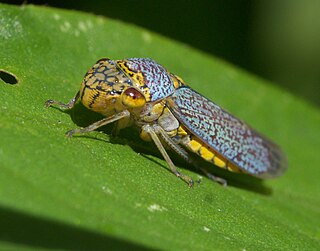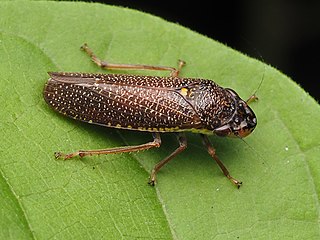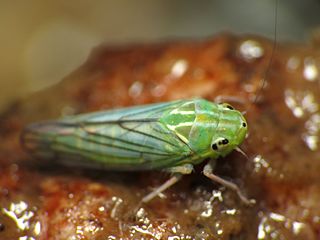
Veins are blood vessels in the circulatory system of humans and most other animals that carry blood towards the heart. Most veins carry deoxygenated blood from the tissues back to the heart; exceptions are those of the pulmonary and fetal circulations which carry oxygenated blood to the heart. In the systemic circulation, arteries carry oxygenated blood away from the heart, and veins return deoxygenated blood to the heart, in the deep veins.

Abies bracteata, the Santa Lucia fir or bristlecone fir, is the rarest fir in North America, and according to some, the world. It is confined to steep-sided slopes and the bottoms of rocky canyons in the Santa Lucia Mountains, in the Big Sur region on the central coast of California, United States.

Dicistroviridae is a family of viruses in the order Picornavirales. Invertebrates, including aphids, leafhoppers, flies, bees, ants, and silkworms, serve as natural hosts. There are 15 species in this family, assigned to three genera. Diseases associated with this family include: DCV: increased reproductive potential. extremely pathogenic when injected with high associated mortality. CrPV: paralysis and death.

The glassy-winged sharpshooter is a large leafhopper, similar to other species of sharpshooter.

Leafhopper is the common name for any species from the family Cicadellidae. These minute insects, colloquially known as hoppers, are plant feeders that suck plant sap from grass, shrubs, or trees. Their hind legs are modified for jumping, and are covered with hairs that facilitate the spreading of a secretion over their bodies that acts as a water repellent and carrier of pheromones. They undergo a partial metamorphosis, and have various host associations, varying from very generalized to very specific. Some species have a cosmopolitan distribution, or occur throughout the temperate and tropical regions. Some are pests or vectors of plant viruses and phytoplasmas. The family is distributed all over the world, and constitutes the second-largest hemipteran family, with at least 20,000 described species.

Brochosomes are intricately structured microscopic granules secreted by leafhoppers and typically found on their body surface and, more rarely, eggs. Brochosomes were first described in 1952 with the aid of an electron microscope. Brochosomes are hydrophobic and help keep the insect cuticle clean. These particles have also been found in samples of air and can easily contaminate foreign objects, which explains erroneous reports of brochosomes on other insects.

Victor Antoine Signoret was a French pharmacologist, physician and entomologist.

The name sharpshooter is used to refer to any of various genera and species of large leafhoppers in the tribe Proconiini of the family Cicadellidae. As with all cicadellids, they have piercing-sucking mouthparts and closely spaced rows of fine spines on their hind legs. The nymphs feed by inserting their needle-like mouthparts into the xylem of the small stems on the plant where the eggs were deposited; the adults have wings and are highly mobile, and most feed on a variety of different plant species. Both nymphs and adults filter a huge volume of dilute liquid through their digestive system to extract the trace nutrients, and much of the water and carbohydrates are squirted forcibly away from the body in a fine stream of droplets, thus earning them their common name.
David Allan Young Jr., was an American entomologist who specialized in the taxonomy of the Cicadellidae and authored a comprehensive treatment of the family with numerous genera and species described and named by him. This work in three parts Taxonomic Study of the Cicadellinae covered 292 genera.

Graphocephala is a large genus of leafhoppers, found from southern Canada to northern South America.

Oncometopia is a genus of sharpshooters found in North and South America. The genus was erected by Carl Stål in 1869.
Onega is a genus of leafhoppers in the family Cicadellidae.

Gonatocerus triguttatus is a species of fairyfly. It is an egg parasitoid of the glassy-winged sharpshooter, Homalodisca vitripennis. It was originally described from Caroni County, Trinidad.

Gonatocerus ashmeadi is a species of fairyfly. Its natural range is Florida, Louisiana, northeastern Mexico, Mississippi, North Carolina, eastern Texas, and southern and central California.
Gonatocerus tuberculifemur is a species of fairyfly. It is an egg parasitoid of Tapajosa rubromarginata, a leafhopper.

Oncometopia orbona, the broad-headed sharpshooter, is a species of sharpshooter in the family Cicadellidae.

Paraulacizes irrorata, the speckled sharpshooter, is a species of sharpshooter in the family Cicadellidae.

Sibovia occatoria, commonly known as the yellow-striped leafhopper, is a species of sharpshooter in the family Cicadellidae. It is native to North and Central America, from the United States to El Salvador.

Neocoelidiinae is a small subfamily in the family Cicadellidae (leafhoppers). It was originally included within the subfamily Coelidiinae.
Gypona is a genus of leafhopper belonging to the family Cicadellidae. Gypona is the largest genus of Gyponini.















